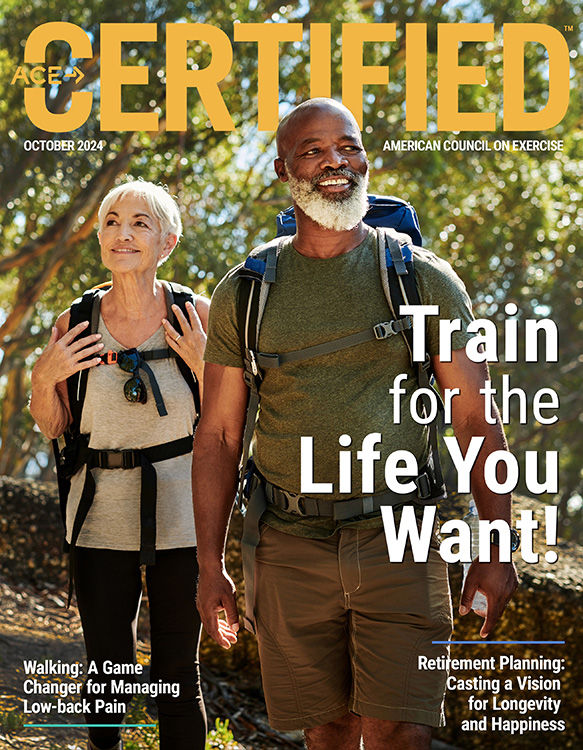
The Impact of Workplace Wellness Programs: Insights From the 15-Minute Challenge Study

Workplace wellness programs are growing in popularity as a way to combat sedentary lifestyles and promote better health outcomes. The 15-Minute Challenge is a recent initiative launched in 73 Australian, New Zealand and United Kingdom companies that emphasizes daily physical activity using a gamified approach to motivate employees. This article explores the results of research analyzing the impact of this approach and provides practical insights that you can use to apply this information in your work with various client populations.
Key Findings From the 15-Minute Challenge Study
The researchers behind the 15-Minute Challenge study set out to investigate the impact of a short-duration, daily physical-activity program on workplace employees. Conducted over six weeks, the program required participants to engage in at least 15 minutes of physical activity each day. Activities ranged from walking and stretching to more vigorous forms of exercise like jogging or strength training. The key feature of the program was its use of a gamified app that tracked participants' activities and fostered a competitive team environment.
Study Design and Methodology
The challenge was structured to encourage engagement and consistency through several mechanisms:
- Daily Activity Tracking: Participants were required to log their physical activity using a mobile app designed for the challenge. This app allowed individuals to track their time spent exercising and see their progress over time.
- Team-based Competition: The study incorporated a social element by organizing participants into teams, with points awarded based on activity duration and consistency. This competitive aspect fostered collaboration and camaraderie, as teams worked together to achieve collective goals.
- Behavioral Incentives: The gamified nature of the challenge included leaderboards, badges and rewards for milestones, which provided participants with positive reinforcement and motivation to keep up with the challenge.
The primary goal of the 15-Minute Challenge was to assess whether a minimal, structured intervention—just 15 minutes of daily exercise—could significantly improve physical activity levels and overall health outcomes in a busy workplace environment.
Baseline and Outcome Measures
Before the study began, participants underwent an initial health and activity assessment to establish a baseline for comparison. This included:
- Self-reported physical activity levels: Participants were asked about their regular exercise habits, including how many days per week they engaged in physical activity and for how long.
- Health outcomes: Several self-reported health metrics, such as energy levels, sleep quality, mood and stress, were analyzed to determine how participants felt about their overall well-being.
- Fitness assessments: Some participants also underwent optional fitness testing to provide objective measures of fitness improvements during the study.
At the conclusion of the study, these measures were reassessed to determine changes in behavior, physical activity and subjective health outcomes.
Results and Key Findings
The 15-Minute Challenge study yielded highly positive results, showing that even a modest amount of consistent daily exercise can significantly improve physical activity levels and health outcomes:
- At the start of the program, only 63% of participants met physical activity guidelines (at least 150 minutes of moderate-intensity exercise per week). By the end of the study, this figure had jumped to 96%, indicating that nearly all participants were regularly achieving recommended activity levels.
- Fitness levels increased by an average of 12.4%.
- Energy levels saw a 14.0% increase, showing that even short bouts of exercise contributed to greater vitality during the workday.
- Mood improvements were reported by participants, with a 10.7% increase in feelings of well-being and positivity.
- Sleep quality improved by 7.1%, indicating that regular activity can have a profound effect on rest and recovery.
These findings highlight the effectiveness of short, manageable bursts of physical activity in achieving health improvements, especially in settings where time and motivation can be barriers to exercise adherence.
Behavioral Insights From the Study
One of the most impactful elements of the 15-Minute Challenge was its use of gamification to enhance motivation. The competitive, team-based environment, reinforced with points and rewards, created a sense of accountability that helped drive participation. Many participants noted that the social aspect of the challenge encouraged them to stay consistent with their exercise routine, as they didn’t want to let their teammates down.
Additionally, the challenge successfully demonstrated that incorporating small, achievable goals—such as 15 minutes of daily activity—can break down psychological barriers to starting and maintaining an exercise routine. For individuals who may feel overwhelmed by the idea of lengthy or high-intensity workouts, the 15-Minute Challenge provided a manageable, incremental path to better health.
Broader Implications for Workplace Wellness
“With the majority of adults spending much of their waking time working, workplaces present ideal settings for promoting physical activity, says lead researcher Dr. Ben Singh, a research fellow at the University of South Australia. “In this study, we showed that as little as 15 minutes per day can make a difference when it comes to people’s health and well-being. And while the program only required 15 minutes of activity, most people tended to do more.”
The success of the 15-Minute Challenge underscores the potential of workplace wellness programs to promote physical activity and improve health outcomes among employees. By integrating easy-to-follow activities with social engagement and gamification, such programs can effectively address the problem of sedentary behavior in work environments.
For health and exercise professionals working with corporate clients, these findings suggest that introducing brief, structured exercise initiatives can be a low-barrier solution to increase physical activity levels. Moreover, by fostering team-based challenges, you can leverage the power of social motivation to keep participants engaged and consistent over time.
The Role of Gamification and Social Support
One of the standout features of the 15-Minute Challenge was its use of gamification to increase engagement. By integrating competition, tracking progress, and celebrating achievements, the app helped foster a sense of community and accountability among participants. Such elements are especially important for adherence to physical activity programs, as social interaction can boost motivation and long-term commitment to exercise?.
As a health and exercise professional, you might consider incorporating social support mechanisms into your own programs, whether through group classes, team challenges or other forms of collaboration. Encouraging clients to set team-based goals, track progress and celebrate successes can keep them engaged and motivated.
Overcoming Barriers to Physical Activity in Sedentary Work Environments
The 15-Minute Challenge study provides a model for overcoming common barriers to physical activity in workplace settings. By focusing on micro-habits—just 15 minutes of activity per day—the program helped break down the psychological and logistical barriers that prevent many employees from engaging in regular exercise.
“The 15-minute goal essentially serves as an accessible starting point—especially for people who are particularly sedentary,” explains Dr. Singh. “So, it reduces barriers to entry and helps build the habit of regular exercise.”
Health and exercise professionals working with corporate clients or those who have sedentary jobs can apply this model by advocating for small, manageable changes to daily routines. For example, they can encourage clients to take walking breaks, use standing desks, or perform simple exercises during work hours. These interventions can have a significant impact on overall activity levels and health outcomes.
Integration With Broader Health Initiatives
The results of the 15-Minute Challenge align with a growing body of evidence supporting workplace wellness programs as effective tools for increasing physical activity and improving health. Research shows that physical activity reduces the risk of chronic diseases such as heart disease, type 2 diabetes, and certain cancers??. Additionally, regular exercise contributes to mental well-being, reducing symptoms of anxiety and depression.
As a health and exercise professional, you can leverage these findings to advocate for more comprehensive wellness initiatives in the workplace. By partnering with employers to implement regular physical activity programs, professionals can support both individual health goals and organizational productivity improvements?.
Practical Applications for Health and Exercise Professionals
Drawing from the success of the 15-Minute Challenge and additional fitness resources, here are several key takeaways for you to consider when designing programs for your clients:
1. Start small and build gradually. As demonstrated by the 15-Minute Challenge, even small amounts of physical activity can lead to significant health benefits. Encourage clients, particularly those who are currently leading a sedentary lifestyle, to begin with manageable goals, such as 15 minutes of activity per day, and gradually increase the intensity and duration over time.
2. Use social and gamified elements. Incorporating social aspects into a fitness program can enhance accountability and motivation. Team challenges, fitness tracking apps and goal-setting exercises can help clients stay engaged, particularly when they see their progress shared with peers.
3. Address core strength and mobility. For clients who spend much of their day seated, core strength and mobility are critical areas to target. Exercises such as squats, lunges and core stabilization drills help improve posture, reduce back pain and enhance overall functional fitness?.
4. Tailor programs to client needs and preferences. Understanding the diverse needs of clients is essential. Generational factors can play a role in exercise preferences, as younger clients may respond well to technology-driven programs, while older clients may benefit from functional strength and mobility training??. Offering varied exercise options like kettlebells or rucking can keep clients engaged and motivated by catering to their interests??.
5. Promote confidence and empowerment through strength training. Strength training offers not only physical benefits but also psychological empowerment??. Introducing weightlifting, kettlebells or other forms of resistance training can boost clients’ confidence and help them see their bodies as tools for empowerment, rather than sources of limitation?.
Conclusion: Applying the Lessons from the 15-Minute Challenge
The 15-Minute Challenge study illustrates the effectiveness of short-duration, consistent physical activity in improving health outcomes, especially when combined with social accountability and gamified elements. As a health and exercise professional, you can apply these insights to your work by promoting small, daily activity goals, leveraging social support and tailoring programs to meet the specific needs of your clients.
By embracing a client-centered approach and using strategies that have proven successful in workplace wellness programs, you can help clients build sustainable fitness habits, improve overall well-being and achieve long-term health benefits.
Expand Your Knowledge
A Holistic Approach to Mental Health
As the conversation around mental health grows, health and exercise professionals have an exciting opportunity to positively impact people’s mental well-being and overall health through services and programming while staying within their scope of practice. From nutrition, movement, breath, sleep and connectedness, there are many ways to help clients focus on their mental health. This course offers insight from five industry experts who share their knowledge about various factors of wellness that can impact your clients’ mental health. Through each session, you’ll learn how to expand your offerings and assist your clients in their quest for better mental health and wellbeing.
Attracting, Engaging and Retaining Successful Staff
Is your health club or fitness facility plagued by high turnover? Low engagement a problem? Revenue missing the mark? Many of these undesirable outcomes are the result of an unengaged, unexcited and underutilized staff. In this video training, you will learn realistic and applicable staffing strategies that can be implemented to bolster your business and help your facility boost its reputation. Attract, grow and retain top employees now so you can reap the benefits of higher revenue and memberships in the future.
Exercise Strategies for Clients With Physically Demanding Careers
Many clients have careers or lead lives that are highly physical, involving excessive time spent on their feet, performing repetitive movements, and carrying or moving heavy objects. These clients can greatly benefit from training that encourages optimal posture, strong foundational movements, and improved stability. In this video training, you’ll explore how focusing on specific movement patterns that relate directly to the physical demands in a client’s life can help them recover from or avoid injury, while improving their quality of life both on and off the job. You’ll also gain an understanding of the collaborative process involved in assessing a client’s lifestyle, as well as the impact that lifestyle has on their body.

More Articles
- Certified™: October 2024
Retirement Planning: Casting a Vision for Longevity, Health and Happiness
Contributor
- Certified™: October 2024
Controlled Articular Rotations: Shifting Mobility into High Gear
Contributor
- Certified™: October 2024
Stabilize From the Inside Out: Unlocking Core Strength With Diaphragmatic Training
Contributor




 by
by 




